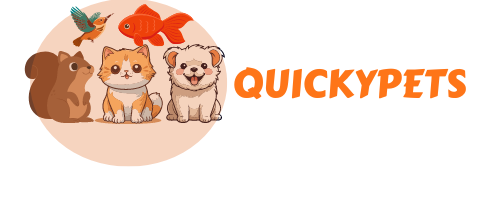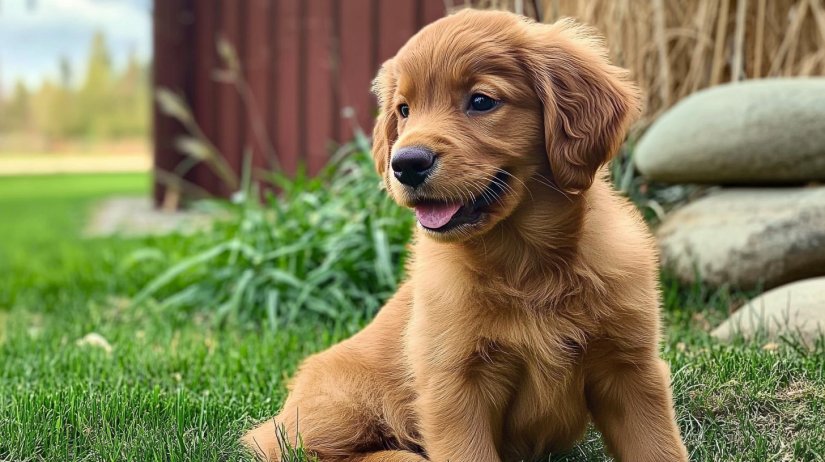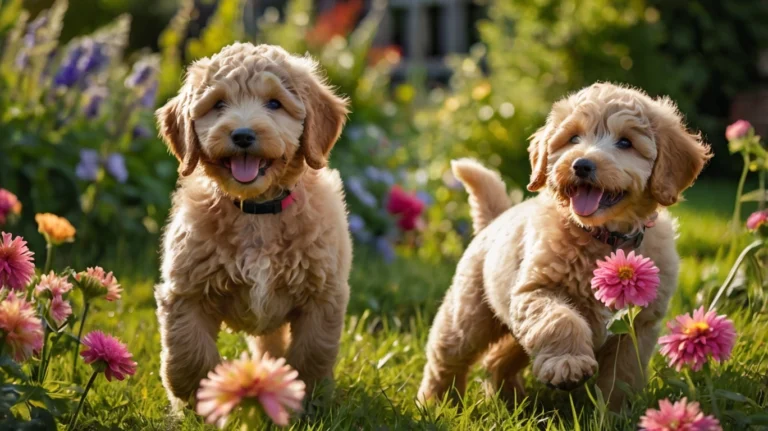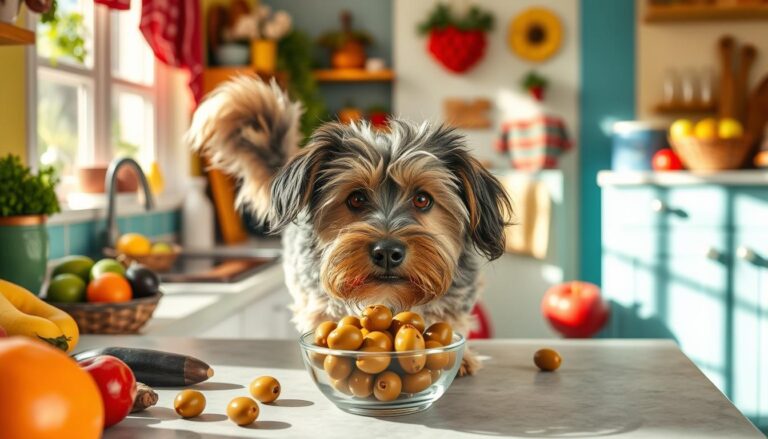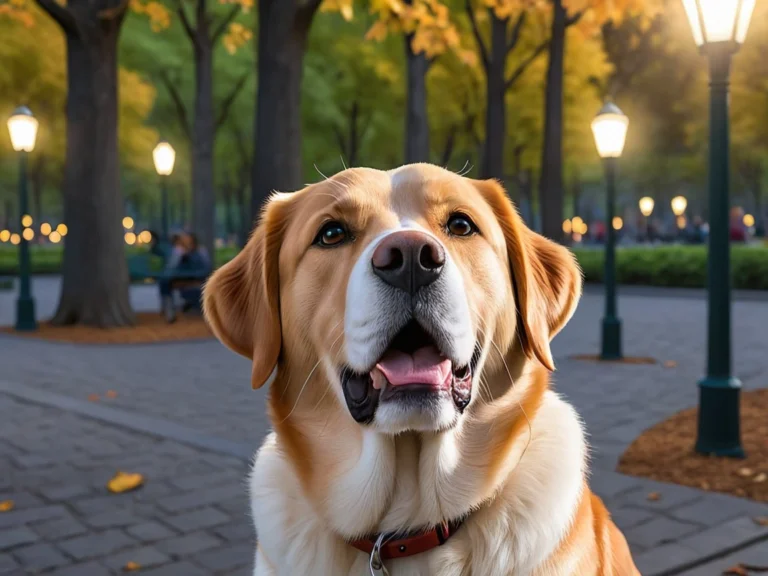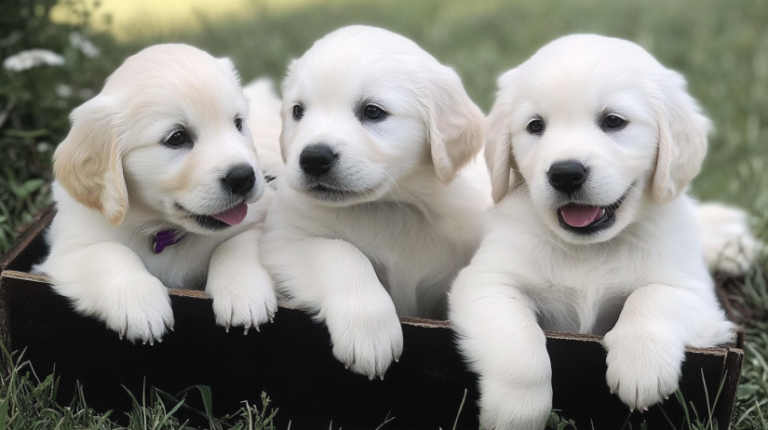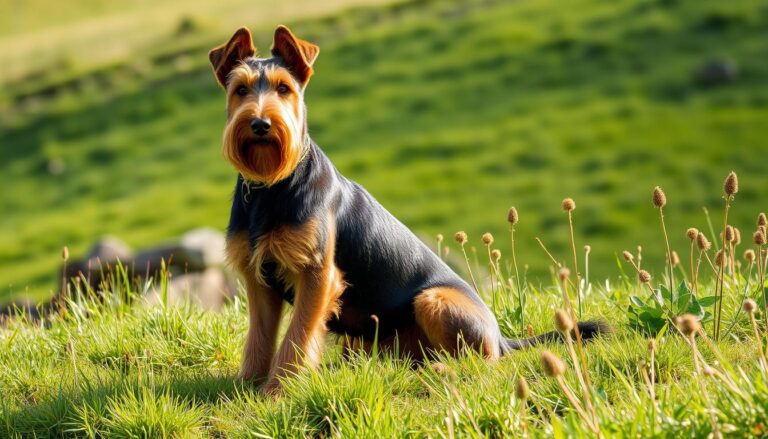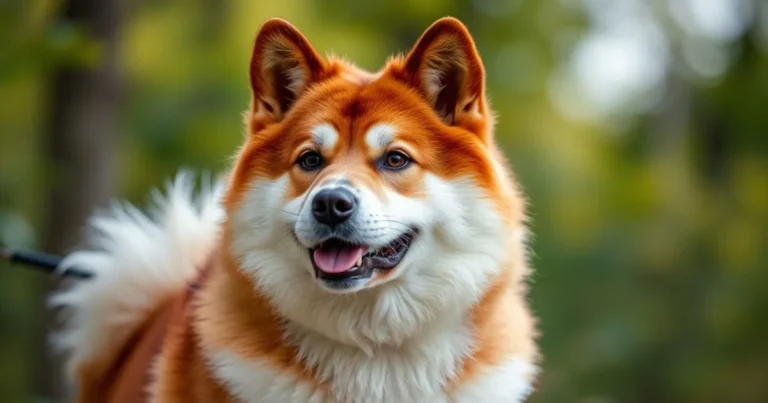Red Golden Retriever Puppy: 9 Amazing & Joyful Facts
Introduction
Picture this: You step through your front door, greeted by a blur of reddish fur bounding enthusiastically toward you, tail wagging like a metronome set to happy mode. That’s the everyday scene when you bring a red golden retriever puppy into your home. While their gorgeous mahogany hue might turn heads, these pups embody the classic Golden Retriever charm—intelligent, eager to please, and joyously social. The difference? A distinct red coat that enhances their already irresistible appeal.
Perhaps you’ve seen photos of a neighbor’s red golden retriever puppy or stumbled upon endearing puppy pictures online. Maybe you’re after a dog that pairs a robust coat color with the famously sweet Golden Retriever personality. Whatever sparked your interest, it’s essential to understand what life with a red golden retriever puppy entails. From proper nutrition and exercise to grooming, temperament, and training tips, there’s plenty to discover. Let’s dive in!
The Story Behind the Red Coat
A Quick Breed History
Golden Retrievers originated in Scotland during the mid-to-late 19th century, created by crossing various retriever and spaniel breeds to produce a skilled hunting companion with a gentle mouth. According to the American Kennel Club (AKC), the Golden Retriever breed standard typically features shades ranging from light cream to rich gold. Over time, certain lines produced deeper, rust-colored coats—leading to what some enthusiasts call the “red” Golden.
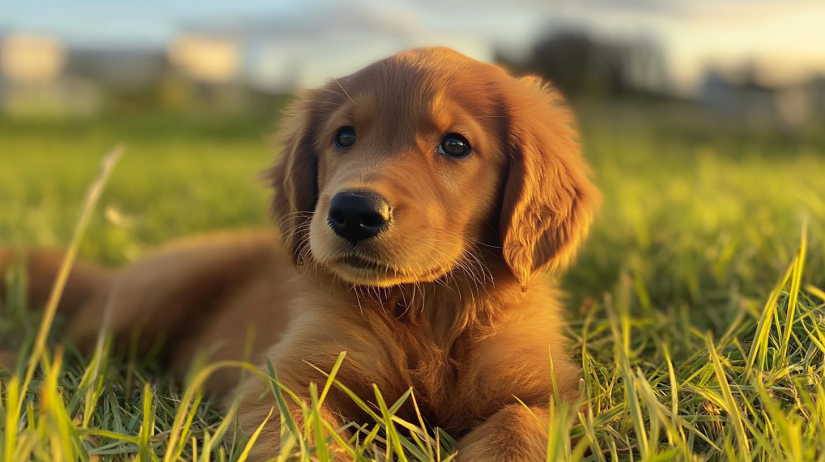
Genetics of the Red Coat
The intense coloring in a red golden retriever puppy results from genes that regulate eumelanin and phaeomelanin pigments. Specifically:
- Phaeomelanin: Responsible for reds, creams, and golds in dogs.
- Modifiers: Genetic modifiers can darken or lighten the coat, producing anything from a pale cream to a deep mahogany.
Ultimately, whether you get a light Golden, a classic gold coat, or a distinctly red golden retriever puppy depends on genetics—a bit of chance combined with lineage. While red-coated Goldens may not conform precisely to every kennel club’s standard, many owners find the color’s eye-catching vibrancy irresistible.
Are Red Goldens Purebred?
Yes—assuming both parents are registered Golden Retrievers, a red golden retriever puppy is still a purebred. The coat color alone does not disqualify them from being genetically Golden Retrievers, though extreme shading might sometimes fall outside official breed standards for show events. Regardless, red Goldens share all the hallmark traits of the breed, from gentle dispositions to unwavering loyalty.
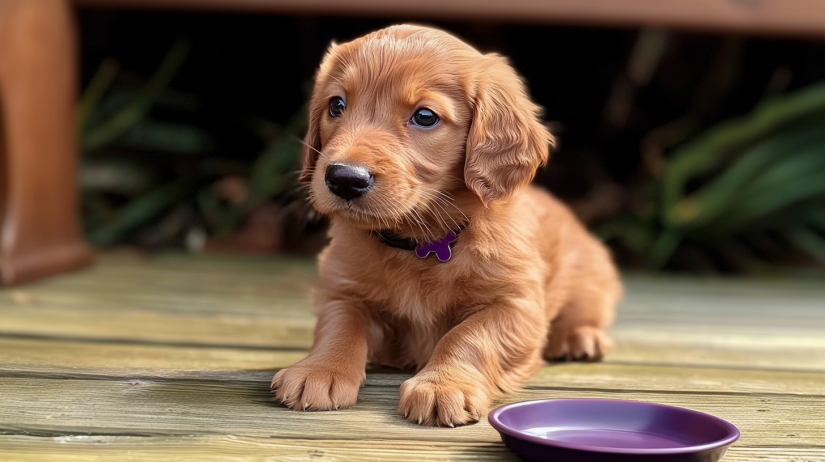
Comparing Red Golden Retrievers to Traditional Goldens
Physical Differences
- Coat Color: A red golden retriever puppy ranges from dark golden to a chestnut or mahogany shade.
- Coat Texture: Some red Goldens have slightly shorter, straighter coats than the plush, feathery fur common in lighter Goldens.
- Build: Red Goldens often come from field or working lines, which can yield a more athletic, leaner physique than some show lines.
Despite these differences, red-coated Goldens remain very similar in overall appearance to their lighter counterparts—medium-to-large bodies, sweet expressions, and that hallmark “feathering” on the legs and tail.
Temperament Traits
All Golden Retrievers, including a red golden retriever puppy, tend to be:
- Friendly & Outgoing: They typically adore people, children, and other animals.
- Intelligent & Trainable: Eager to learn commands, from basic obedience to advanced tasks.
- Playful & Energetic: They need daily exercise and can become restless if under-stimulated.
- Gentle: Their soft mouths and calm dispositions make them ideal family dogs.
The only temperament variation sometimes noted in red Goldens stems from their field-line heritage, which can lead to higher energy and drive. However, each red golden retriever puppy has a unique personality, so it’s crucial to provide consistent guidance regardless of color or lineage.
Welcoming Your Red Golden Retriever Puppy Home
Preparations & Puppy-Proofing
Before your red golden retriever puppy arrives, invest time in creating a safe, welcoming space:
- Secure Loose Items: Red Golden puppies love to explore with their mouths. Move breakables and tuck away cords.
- Block Off Dangerous Areas: Use gates or closed doors to limit access to stairs or off-limits rooms.
- Stock Up on Essentials: Purchase a crate, bedding, puppy food, treats, toys, grooming tools, and cleaning supplies.
Settling In: The First Few Days
When your red golden retriever puppy steps paw into your home, keep the experience calm and supportive:
- Designate a Cozy Spot: A crate with soft bedding provides a secure den.
- Set a Routine: Feed, walk, and play at consistent times to establish predictability.
- Encourage Exploration: Allow the puppy to sniff around while you supervise. Offer gentle reassurance when they seem uncertain.
Pro Tip: Use a blanket or plush toy with the puppy’s litter scent to ease separation anxiety in those first nights.
Socializing Your Puppy
A red golden retriever puppy is naturally sociable but requires structured socialization to grow into a well-rounded adult:
- Introduce Gradually: Meet new people, pets, and environments one at a time.
- Reward Positivity: Use treats and praise when your puppy greets politely or remains calm in new places.
- Puppy Classes: Group sessions offer invaluable opportunities to practice manners among other canines.
Feeding & Nutrition
Choosing the Right Diet
Proper nutrition sets the foundation for your red golden retriever puppy’s long-term health. Look for high-quality puppy food that includes:
- Animal-Based Proteins: Chicken, turkey, fish, or lamb as primary ingredients.
- Balanced Fat & Carbohydrates: Helps support growing bones, healthy coat, and energy needs.
- Essential Vitamins & Minerals: Especially calcium, phosphorus, and DHA for brain and vision development.
Always read labels carefully. Some owners opt for veterinarian-prescribed diets or limited-ingredient formulas for pups with sensitivities. Consult your vet if you’re unsure which route to take.
Feeding Frequency & Portion Sizes
Puppies require multiple small meals throughout the day:
- 2–3 Months Old: 4 meals per day
- 3–6 Months Old: 3 meals per day
- 6–12 Months Old: Transition to 2 meals per day
Monitor your red golden retriever puppy’s body condition—ribs should be palpable but not overly visible. Overfeeding can lead to obesity, which strains joints and may cause long-term health problems. Your vet can provide portion guidelines tailored to your puppy’s growth rate.
Avoiding Harmful Foods
Some human foods can harm a red golden retriever puppy. Steer clear of:
- Chocolate & Caffeine
- Grapes & Raisins
- Onions & Garlic
- Xylitol (a sweetener in some gums and candies)
- Excessively Fatty or Salty Snacks
When in doubt, stick to dog-friendly treats or consult your veterinarian before sharing table scraps.
Health & Wellness Basics
Common Golden Retriever Health Concerns
All Golden Retrievers, including a red golden retriever puppy, may be predisposed to:
- Hip & Elbow Dysplasia: Abnormal joint development causing pain or lameness.
- Heart Conditions: Such as subvalvular aortic stenosis.
- Eye Disorders: Cataracts or progressive retinal atrophy.
- Cancer: Goldens have a higher-than-average cancer incidence, making regular vet checkups crucial.
Early screenings, responsible breeding practices, and a proper diet/exercise regimen help mitigate risks. Discuss these concerns with your vet so you can adopt preventive measures.
Vaccinations & Preventive Care
Ensure your red golden retriever puppy receives core vaccinations, including:
- Distemper
- Parvovirus
- Adenovirus
- Rabies
Non-core vaccines (like Bordetella or Lyme) may be recommended based on regional or lifestyle factors. Additionally, safeguard your pup against fleas, ticks, and heartworms through monthly preventives recommended by your veterinarian.
Grooming Essentials
A red golden retriever puppy typically has a medium-length, water-resistant coat. While the deeper color doesn’t change grooming needs significantly compared to lighter Goldens, consistency is key:
- Brushing: At least 2–3 times weekly to remove loose hair and minimize matting.
- Bathing: Every 6–8 weeks (or as needed) using a dog-specific shampoo.
- Nail Trimming: Trim nails once they start clicking on the floor—usually every 3–4 weeks.
- Ear Cleaning: Check for redness or wax buildup, especially after swimming or baths.
Regular grooming helps maintain that glorious red coat, while also strengthening the bond with your puppy as they learn to trust your touch.
Training Your Red Golden Retriever Puppy
Positive Reinforcement: The Key to Success
Golden Retrievers are renowned for their eagerness to please, and a red golden retriever puppy is no exception. Positive reinforcement methods—treats, praise, toys, or play—encourage good behavior while maintaining your pup’s enthusiasm. Avoid harsh corrections that might undermine confidence or trigger anxiety.
Basic Obedience Essentials
Start simple to establish trust and structure:
- Sit: Use a treat above their nose, then move it back so they naturally sit.
- Stay: Train them to hold their position until you give a release command like “OK!”
- Come: Encourage them to come eagerly by using high-value treats and enthusiastic praise.
Keep sessions brief—5 to 10 minutes at a time—so your red golden retriever puppy stays focused and ends on a positive note.
Social Skills & Polite Greetings
Red Goldens can be exuberant greeters, so consistent training helps avoid jumping or overly boisterous hellos:
- Four Paws on the Floor: Reward calm greetings and ignore jumping.
- Leash Manners: Practice short walks with frequent “check-ins” to build good leash habits.
- Exposures: Vary your puppy’s environment—parks, city sidewalks, pet-friendly stores—to develop confidence in novel situations.
Crate & House Training
A crate can serve as a secure den for your red golden retriever puppy, aiding in housebreaking and providing a retreat when they’re overwhelmed. Follow these steps:
- Positive Introductions: Line the crate with soft bedding and toss treats or toys inside.
- Gradual Alone Time: Leave the puppy in the crate for short intervals, extending the duration as they grow comfortable.
- Accident Prevention: Take them out for potty breaks regularly—after waking, meals, and play—praising them for eliminating outdoors.
Exercise & Playtime
Balancing Activity and Growth
A red golden retriever puppy brims with curiosity and moderate energy, requiring daily activities to stay content. However, excessive exercise can strain developing joints. Aim for:
- Short Walks: 5 minutes of structured walking per month of age, up to twice a day, is a common guideline.
- Gentle Fetch Sessions: Provide mental stimulation without overexertion.
- Swimming: Many Goldens love water—just ensure your puppy’s introduction to swimming is calm and supervised.
Fun Games & Enrichment
- Puzzle Toys: Encourage problem-solving and keep your pup’s mind engaged.
- Hide & Seek: Hide treats around the house or yard, letting them sniff out the surprises.
- Flirt Pole: Dangle a toy on a rope to mimic prey-chasing in short bursts, promoting agility.
Note: Always adjust play intensity to your puppy’s energy level and watch for signs of fatigue or overexcitement.
Table: Developmental Milestones for Your Red Golden Retriever Puppy
Below is a general timeline for a red golden retriever puppy (though individual pups may vary).
| Age (Months) | Approx. Weight (lbs) | Milestones |
|---|---|---|
| 2–3 | 10–25 | First vaccinations, bonding with new family, learning basic routines |
| 4–5 | 25–45 | Teething phase, basic commands, crate/house training progress |
| 6–7 | 40–60 | More advanced obedience, social outings, booster vaccinations |
| 8–10 | 50–65 | Teen phase (some independence), moderate exercise, refining manners |
| 11–12 | 60–70 | Approaching adult size, consistent discipline for impulse control |
| 12–18 | 65–75+ | Full adult size, final coat growth, potential for advanced activities |
Note: This weight chart is approximate. Consult your veterinarian to track healthy growth.
Behavior & Personality Insights
The Classic Golden Temperament
Expect these shared traits from a red golden retriever puppy:
- Warmth & Friendliness: Red Goldens typically greet humans and animals with wagging enthusiasm.
- People-Oriented: They thrive on attention and can experience separation anxiety if isolated too often.
- High Emotional Sensitivity: Yelling or harsh treatment may cause anxiety or confusion. Use gentle guidance.
Puppyhood Challenges
Every puppy experiences ups and downs, and a red golden retriever puppy is no exception:
- Nipping/Play Biting: Offer chew toys or redirect to curb this natural puppy behavior.
- Mouthing Objects: A curious pup might gnaw on shoes, furniture, or random items. Puppy-proof thoroughly and supervise.
- Zoomies: Sudden bursts of energy, especially in the evening—plan interactive play to channel that excitement.
Addressing Undesirable Behaviors
- Jumping Up: Turn away or ignore your puppy until all four paws land on the floor, then reward them for calmness.
- Chewing: Provide plenty of chew options. If you catch them chewing something off-limits, calmly redirect to an appropriate toy.
- Over-Excitement: Gently guide your puppy to a “sit” or “down” to slow them down. Offer a moment of quiet time if they seem overstimulated.
Working Roles & Activities
Therapy & Service Dog Potential
The Golden Retriever’s well-known empathy and trainability suit them for therapy or service work. A red golden retriever puppy can excel in:
- Therapy Visits: Comforting patients in hospitals or nursing homes.
- Emotional Support: Providing solace for individuals with anxiety or depression.
- Assistance Tasks: Helping those with physical disabilities by retrieving items or flipping switches.
Keep in mind that specialized training for therapy or service roles typically requires a year or more of structured lessons plus temperament assessments.
Canine Sports & Advanced Obedience
With their intelligence and energy, many red Goldens shine in:
- Agility: Navigating obstacle courses fosters mental and physical prowess.
- Rally Obedience: Performing a series of tasks at stations, judged on precision and teamwork.
- Dock Diving: Jumping enthusiastically off a platform into water—perfect for water-loving Goldens.
These sports can be a fun outlet for your red golden retriever puppy, reinforcing your bond and preventing boredom.
Real-Life Examples: Success Stories
Case Study 1: Maggie the Majestic
Maggie arrived as a shy red golden retriever puppy with a cautious streak. Her family dedicated time to gentle socialization at the local dog park. Over months of patient training, Maggie blossomed into a well-adjusted dog who adores fetch games and greets new people with a happy tail wag. She now volunteers as a reading buddy at a neighborhood library, where kids read stories to her calm presence.
Key Lesson: Early patience, gentle exposure, and consistent praise help a timid puppy find confidence.
Case Study 2: Rusty the Outdoorsman
Rusty was a red golden retriever puppy whose strong field-line heritage was apparent the moment he darted after leaves in the yard. His owners channeled this high energy into structured morning runs and weekend hikes. Through advanced obedience classes, Rusty’s recall and off-leash manners became reliable, enabling him to join the family on camping trips and even moderate trail runs.
Key Lesson: Providing an active dog with plenty of exercise and mental tasks can yield a content, well-mannered adventurer.
FAQs
Below are user questions related to Golden Retrievers, chosen for their broad relevance.
Do Golden Retrievers have high intelligence?
They’re widely known for their problem-solving abilities. A red golden retriever puppy learns quickly through consistent, positive training. Mental stimulation keeps them happy and well-behaved.
Do Golden Retrievers fit well in households?
They generally love people, including children and other pets. A red golden retriever puppy thrives in a home offering affection and consistent guidance. Adequate exercise completes their family-friendly nature.
How should you approach training a Golden Retriever?
Rely on rewards and gentle guidance for best results. A red golden retriever puppy excels with praise, treats, and play. Short, consistent lessons foster faster learning and cooperation.
What’s an ideal exercise routine for Golden Retrievers?
Aim for regular walks and interactive playtime each day. A red golden retriever puppy loves short, engaging activities that burn energy. Build up gradually as they mature to protect their developing bones.
Are Golden Retrievers friendly toward other canines?
Most are quite sociable, given careful introductions. A red golden retriever puppy usually welcomes playmates and group outings. Confidence grows through positive encounters and consistent manners training.
Will Golden Retrievers leave fur around the home?
They naturally shed, especially during spring and fall. A red golden retriever puppy gradually sheds puppy fluff as adult fur emerges. Regular brushing helps limit loose hair and keep coats healthy.
Conclusion
A red golden retriever puppy is more than a striking coat color—it’s a vivacious, loving companion with all the signature Golden Retriever virtues. Whether you plan to enjoy leisurely family outings, engage in canine sports, or even explore service dog work, a red golden retriever puppy offers loyal devotion and a ready-to-please attitude. With balanced nutrition, proper socialization, and positive training, your pup can thrive in any environment, brightening every day with that trademark Golden grin. If you’re ready to open your home to this breathtaking canine, prepare for a lifetime of wagging tails and heartwarming moments. Have your own stories about raising a red golden retriever puppy? Share your experiences in the comments below and help others embark on this wonderful journey!
For additional resources on dog health, adoption, and best practices, consider visiting the American Society for the Prevention of Cruelty to Animals (ASPCA). Their site offers extensive tips on responsible pet ownership, training advice, and more—perfect for first-time or experienced dog parents eager to give their red golden retriever puppy the best start possible.
